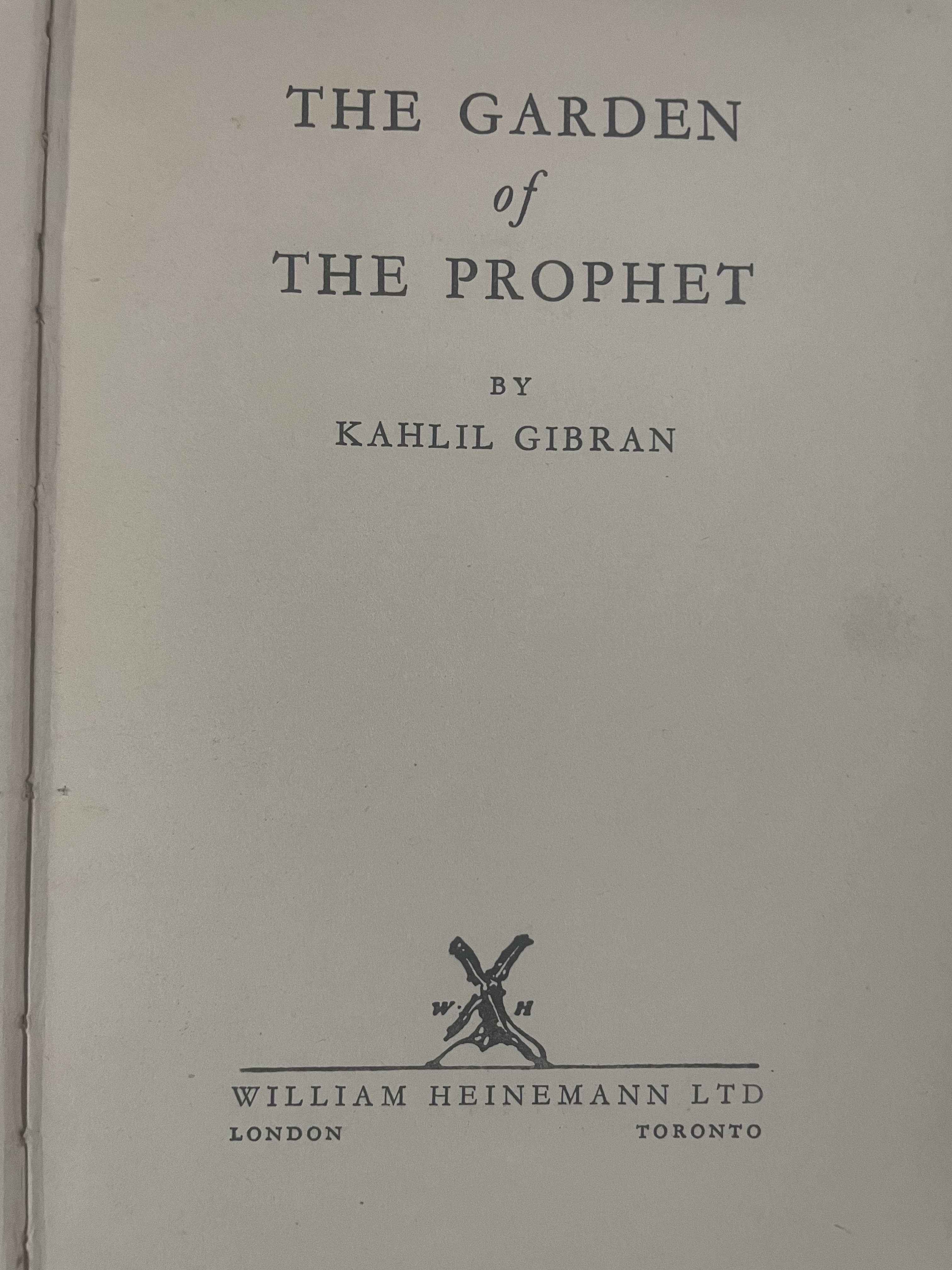The Garden of the Prophet

About
Summary
Exquisite
TOC
Details
Related
URL
Images
Overview
The Garden of the Prophet, written by Kahlil Gibran and published in 1933, is a sequel to his renowned work, The Prophet. While The Prophet explores Almustafa's insights on various aspects of human existence before leaving the city of Orphalese, The Garden of the Prophet narrates Almustafa's return to his homeland and his subsequent dialogues with nine disciples, focusing on humanity's relationship with nature and the divine. The book, intended to be a companion to The Prophet, is a lyrical celebration of the mystical beauty of Nature. However, Gibran died before he could complete it, and the book was published posthumously, edited by a friend.The Garden of the Prophet depicts Almustafa after his return to his island, where he had spent his youth. He is no longer departing but has returned to his source. The narrative centers around his interactions with nine disciples in a garden, where he shares his wisdom on the interconnectedness of humanity, nature, and the cosmos. The book consists of a series of prose poetry fables, similar to The Prophet, but with a stronger emphasis on humanity's relationship with the natural world and the boundless self. Gibran's friend created a loose framework where the prophet Almustafa returns to his home land and speaks his words of wisdom to his nine disciples. The words were Gibran’s own, but not the framework.
Importance of Book
The Garden of the Prophet complements The Prophet by offering further insights into Gibran's spiritual philosophy. It underscores the significance of nature as a source of wisdom and inspiration, urging readers to recognize their place within the larger cosmic order. While The Prophet deals with man's relationship with man, this book concerns itself with man’s relationship to nature instead.
Key Themes
Harmony with Nature: The book emphasizes the importance of living in harmony with nature, recognizing its inherent wisdom and beauty. Almustafa encourages his disciples to see themselves as part of the natural world, respecting its rhythms and cycles.
The Boundless Self: Gibran explores the idea of the "giant self" within each individual, suggesting that our earthly lives represent only a fraction of our true potential. He encourages readers to recognize and embrace their boundless selves, striving for self-knowledge and personal growth.
Spiritual Growth and Transformation: The book delves into the process of spiritual growth, offering guidance on how to overcome limitations, cultivate inner peace, and align oneself with the divine. Almustafa encourages his disciples to seek wisdom, embrace love, and live with compassion.
Interconnectedness: A core theme is the interconnectedness of all things. Almustafa teaches that separation is an illusion, and that we are all part of a greater unity.
The Divine Within: Gibran emphasizes the presence of the divine within each individual, urging readers to recognize their inherent worth and potential. He suggests that by connecting with their inner selves, they can experience a profound sense of peace and fulfillment.
Cultural Significance
Spiritual Inspiration: Gibran's works have provided spiritual inspiration to millions of readers around the world, transcending cultural and religious boundaries.
Influence on Spirituality and Self-Help: His writings have influenced the fields of spirituality and self-help, encouraging readers to seek inner peace and live with purpose.
Promotion of Eastern Philosophy: Gibran's works have contributed to the popularization of Eastern philosophical concepts in the Western world, fostering cross-cultural understanding and exchange.
Effects on Society
Encouraging Spiritual Exploration: His works have inspired individuals to embark on their own spiritual journeys, seeking meaning and purpose in their lives.
Promoting Universal Values: Gibran's message of love, compassion, and unity has resonated with readers across diverse backgrounds, fostering a sense of shared humanity.
Inspiring Creativity and Artistic Expression: His lyrical prose and profound insights have inspired artists, writers, and musicians, contributing to a rich tapestry of creative expression.
Conclusion
The Garden of the Prophet by Kahlil Gibran serves as a lyrical and insightful exploration of humanity's relationship with nature, the boundless self, and the divine. While it may not be as widely known as The Prophet, it provides valuable guidance on cultivating inner peace, embracing self-knowledge, and living in harmony with the world around us. Its cultural significance lies in its contribution to the fields of spirituality, self-help, and cross-cultural understanding, inspiring readers to seek meaning, embrace their potential, and connect with the greater universe. Even though this didn’t flow together or was as perfectly organized as The Prophet, I enjoyed much of what Almustafa had to say.
Table of Content
\"The Garden of the Prophet\" by Kahlil Gibran, published in 1935, is a collection of philosophical and poetic essays that continue the spiritual and reflective themes found in Gibran\'s earlier works. This book serves as a companion to his famous work, \"The Prophet.\"Table of Contents for the 1935 Edition:
PrefaceIntroduction by Kahlil Gibran, offering insights into the themes and purposes of the collection.
The Prophet\'s ReturnA narrative continuation of the themes from \"The Prophet,\" exploring the return of the prophet and his reflections.
The VisionA poetic essay focusing on visionary experiences and philosophical insights.
The Garden of the ProphetThe central piece of the collection, consisting of philosophical musings and reflections presented in a poetic form. The garden serves as a metaphor for spiritual growth and enlightenment.
The Song of the ProphetA lyrical and reflective essay that delves into the spiritual and emotional aspects of the prophet\'s journey.
The AscensionA concluding piece that deals with themes of spiritual ascension and the quest for higher understanding.
The Eternal QuestAn exploration of the eternal search for meaning, purpose, and connection in life.
The End of the Prophet\'s JourneyThe final reflections and conclusions of the prophet\'s journey, tying together the themes of the collection.
Title
The Garden of the Prophet
Author
Kahil Gibran
Name of Publisher
William Heinemann Ltd
Publish Date
1935
Subject
A collection of philosophical and poetic essays that continue the spiritual and reflective themes found in Gibran\'s earlier works
Vintage
1901-1947
Edition
First
Category
Poetry
Sub Category
Literary
Rarity
RARE
